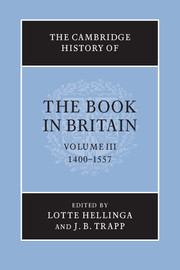Crossref Citations
This Book has been
cited by the following publications. This list is generated based on data provided by Crossref.
Oosthuizen, Susan
and
Taylor, Christopher
2000.
‘John O'Gaunt's House’, Bassingbourn, Cambridgeshire: a fifteenth-century landscape.
Landscape History,
Vol. 22,
Issue. 1,
p.
61.
Barnard, John
McKenzie, D. F.
and
Bell, Maureen
2002.
The Cambridge History of the Book in Britain.
Baker, J. H.
2002.
The Cambridge History of the Book in Britain.
p.
474.
Black, Alistair
2006.
Information history.
Annual Review of Information Science and Technology,
Vol. 40,
Issue. 1,
p.
441.
Hannabuss, Stuart
2007.
Out of Print and Into Profit: A History of the Rare and Secondhand Book Trade in Britain in the Twentieth Century.
Library Review,
Vol. 56,
Issue. 5,
p.
428.
Weedon, Alexis
2008.
A Companion to the History of the Book.
p.
33.
Snook, Edith
2013.
Recent Studies in Early Modern Reading.
English Literary Renaissance,
Vol. 43,
Issue. 2,
p.
343.
2014.
A Companion to British Literature.
p.
418.
Bell, David N.
2014.
A Companion to British Literature.
p.
355.
Driver, Martha W.
2017.
The Encyclopedia of Medieval Literature in Britain.
p.
1.
Weedon, Alexis
2019.
A Companion to the History of the Book.
p.
31.
Connolly, Margaret
2019.
Sixteenth-Century Readers, Fifteenth-Century Books.
Hellinga, Lotte
2019.
A Companion to the History of the Book.
p.
377.
Shaw, David J.
2019.
A Companion to the History of the Book.
p.
393.
CONDORELLI, MARCO
2021.
Positional spelling redistribution: word-initial <u>/<v> and <i>/<j> in Early Modern English (1500–1700).
English Language and Linguistics,
Vol. 25,
Issue. 4,
p.
799.
Gray, Madeleine
2022.
THE WRITING BEHIND THE WALL: TEXT AND IMAGE IN LATE MEDIEVAL CHURCH DECORATION.
The Antiquaries Journal,
Vol. 102,
Issue. ,
p.
228.



